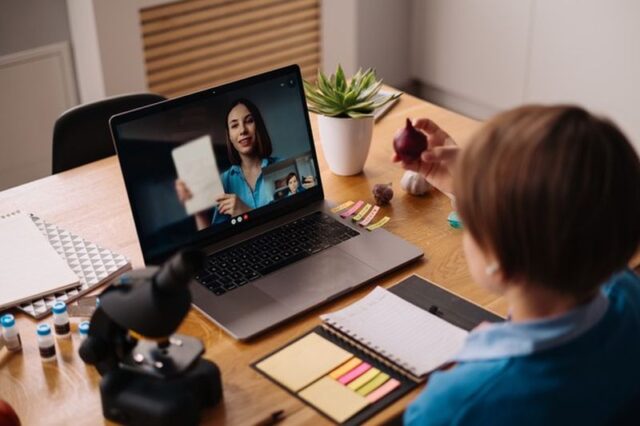Be it the choice of picking from a diverse selection of diplomas, professional degrees, attending courses, lectures, or classes anytime from the comfort of your home, the online learning experience is such bliss. You will most certainly find more than one compelling reason to take up online classes.
Beyond the array of benefits it offers, is there anything that can better this unique learning process? The answer to this question will be unravelled today in this article.
Here, we will take a look at ten of the best ways to better the overall online learning experience and take it to the next level. So, let us get started and address them one by one.
Develop a rapport with the students

Only because both of you are behind the screen, it should not mean that you have to omit the human element. Of course, there is a physical distance, and you cannot do anything about it, but do not make this physical distance social distance.
‘One of the best ways to engage your students is by establishing an emotional connect with them. In a face-to-face class, most teachers are organically able to build this connection. However, in the online environment, you have to take dedicated efforts for establishing this rapport,’ comments Janet, an educator who offers online lessons with ThanksForTheHelp.
There should be proper interaction between professors and students to enable meaningful discussions and build a feeling of trust between professors and students. So, as soon as you begin the lecture, you should start working on building this connection.
You can utilize visuals and storytelling when you speak about yourself. Provide the students with an opportunity to get to know you better. You can accept questions about the teaching methods, your research, and anything related to your career. Further, you can even motivate the students to introduce themselves to the class. You can utilize fun ice-breakers. These can help build trust and boost teamwork.
Use the first five minutes of the session to speak to the students, ask them how they feel, their learning goals and expectations from the class, and any challenges they may be experiencing. This is an incredible kickstart as it will help the participants be at ease and motivated to engage with you.
It would help if you memorized the names of your students and always call them by their names. It is always a good idea to remember the vital details about them. It helps them feel special and unique. Further, use professional and personal stories all throughout the lessons to establish an effective, safe, and fun learning environment.
Courses empowered with videos

Since digital videos are getting hugely popular, utilizing them in the eLearning process would help create a convenient and versatile flare to education. Hence, you must never ignore the videos as they are vital for the students, teachers, and educational institutions. But what does having videos result in? Let us find out:
Having videos helps engage sensory experience
With the videos, it is easy for the learners to see and hear the different concepts, which are being taught, and these will be processed in the same manner as in everyday face-to-face interactions. Moreover, the videos are incredibly helpful in the whole learning process, especially when explaining complex topics, which demand a higher level of understanding.
Go-to resources
Videos are one of the best go-to resources. These can be viewed anytime and anywhere and from any and every device of your choice. So, if you have access to the internet, you can conveniently watch and learn from various devices, such as laptops, tablets, and smartphones.
Improves digital proficiency
If a student uses the videos, it certainly betters the whole online learning process. It improves digital competency. Hence, this is indeed one of the essential skill-sets, which has come in quite handy in the 21st century.
Ask Questions
One of the major con of online education is that it can feel a bit impersonal. When you are in a normal classroom setting, you may have so many reasons not to put forth your doubts in front of the professor. You may be shy, you may not want to halt the class to clear your doubts, or you must just feel under-confident in clarifying your doubts in a class full of 40-60 (or maybe more) students. Do not let the virtual experience shun you from putting forth your doubts.
If you do not find it comfortable enough to put forth your doubts in front of the whole class, write down the same in an email and send it to your online instructor. Share the exact nature of the problem, and be assured, your instructor or tutor will do everything they can to help you overcome these doubts.
At all times, your instructor is there to cater to your doubts. So, do make the most of their knowledge.
Create accessible content

When you produce accessible content, it lowers the comprehension barriers, thereby ensuring that your content is conveniently accessible to everyone, even the people with disabilities and those who do not understand English very well.
See, you should, by default, assume that whatever document you produce will appear on the device of someone with a disability. So, work extra hard on the accessibility. Unlike traditional paper, you can make everything more accessible with digital tools and employment of accessible practices in online content. However, for this, you need to have the right know-how.
For instance, if you take pictures or screenshots of a document that post or share on the internet, this is not accessible. So, be careful with what you share to ensure that every content is accessible. Also, do not scan the document as it is difficult to read such content via a screen reader. Instead, you can create new content with accessibility in your mind. Thus, learning to produce content with proper heading structure, proper color contrast, alternative text, closed captioning for videos, and meaningful hyperlinks is pivotal. Further, it is also quintessential to write in simple language. This makes it easy for you to understand and translate content.
Motivate the students
Motivation is incredibly effective to better learning. It is indeed the single most vital contributor to the relevance of the course. Hence it is quintessential to discuss the value, utility, and applicability from the beginning itself.
‘As an educator, it is your responsibility to enable the students to comprehend the manner in which your course offers a vital foundation to the more advanced courses. More so, make them understand the kind of skills this course will provide them with and how they will benefit from it in the long run. You can even share the issues and the questions that they can expect to get answers for as part of this course,’ comments Norah, an online tutor with FineGrades.
Opt for a more activity-based learning

Now that the students are learning from home, you need to take special steps to keep them interested. For this, you can indulge them in several different interactive activities. These activities can help them learn better and not stare blankly at the screen. Though quizzes and PPTs are an incredible way to prevent students’ attention from wavering, smaller students will love the physical activities and game-based learning more.
You can try out some simple real-life games, wherein you indulge them in some simple art and craft, basic cooking with fire, getting better at writing responses, and alike. It can be an incredible way for students to get creative and make the most of this extra energy.
Implement Virtual Reality (VR)
As many of you may be aware, Virtual Reality is a relatively new technology. Despite that, it has taken over the whole eLearning scene and is growing at a rapid speed. The primary reason behind the employment of VR in education depends on the functioning of the human brain. On average, the brain can remember only ten percent of what it reads, twenty percent of what’s heard, and ninety percent of what is stimulated or done. A few of the best ways in which VR can be in included in online learning include:
Content Creation
At present, VR courses are majorly focused on science and history, but the fact of the matter is that technology can be employed on any subject or theme. So, the possibilities are endless.
Special education
It will mainly be helpful for students with physical disabilities. So, in all, VR can be a blessing in disguise. With VR, you get to explore the whole world using your headset. This may leave a phenomenal impact on the overall learning process too.
Field trips
VR helps the students be at places, which are distant or physically inaccessible. So, in a way, it offers them a sense of physical presence. Overall, these classes are indeed a superior competitor to the traditional classrooms.
Support and identify struggling students

‘When a student cannot maintain pace with the online sessions, he tends to drop out of the courses. And given the ongoing situation, there are so many students who are struggling. Many of them even encounter issues, which go beyond the academic context. Thus, educators need to be very careful in such situations,’ comments Donna, an educator with TopAssignmentExperts.
Let us explain what Donna means by this. We are living in a time when all of us are faced with a pandemic. At this time, there may be so many students who may be battling the loss of someone close to them. Many may even be dealing with mental health issues. There are also so many students who have dyslexia, attention deficit, hyperactive disorder (ADHD and many other learning disorders. Some may even be dealing with the fear of evaluation and judgment, stress, and anxiety.
In this time, empathy in teaching is quintessential. As a teacher, you need to check on your students’ mental health regularly. If you see that any of them is lagging behind, communicate with them immediately or send out prompt alerts so serious damage occurs. Further, during office hours, you should make yourself available to the students for a quick checkup or a one-to-one tutoring session if they have any doubts.
Motivate the students to always come up to you for doubts anytime they feel lost or are struggling with the schedules, technology, learning material, or any other non-academic needs. Provide them timely feedback, be flexible with the deadlines, and offer various assessment alternatives.
Have a schedule
Of course, there will not be any bells in learning from an online setup, but that does not mean that there should be no discipline either. Both students and teachers need to have a schedule. You can have this schedule available to each student, so they know when they have their session due with you. The schedule must indicate things, such as:

- Office hours – When can the students collaborate with the teachers for office hours,
- Drop time – What time of the day should they expect their assignments.
- Live instructions – When will they get all the live instructions from you.
- Social hours – When can both the students and the teachers work together and socialize.
Teach as if there are no walls
Lastly, to make eLearning better, you have to teach like there are no walls in between, as there literally aren’t any balls between you and the students. Find out ways to tailor the sessions. At all times, you should have your students interested in the subject or the class. However, there may also be instances when the students wish to learn from a different educator or take a session that they may not originally have to take.
Of course, it means that they want to challenge themselves. If that’s the situation, you should be flexible with them and let them try it. If they want to take a bigger course load, be it. If a particular teacher’s instruction time fits them better, allow them to make changes according to them. Overall, it is easy to learn faster and better in online learning if imparted the right way with the right technique.







